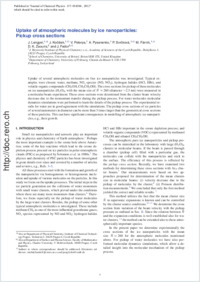Uptake of atmospheric molecules by ice nanoparticles: Pickup cross sections
- Lengyel, J. J. Heyrovský Institute of Physical Chemistry v.v.i., Academy of Sciences of the Czech Republic, Prague, Czech Republic
- Kočišek, J. J. Heyrovský Institute of Physical Chemistry v.v.i., Academy of Sciences of the Czech Republic, Prague, Czech Republic
- Poterya, V. J. Heyrovský Institute of Physical Chemistry v.v.i., Academy of Sciences of the Czech Republic, Prague, Czech Republic
- Pysanenko, A. J. Heyrovský Institute of Physical Chemistry v.v.i., Academy of Sciences of the Czech Republic, Prague, Czech Republic
- Svrčková, P. J. Heyrovský Institute of Physical Chemistry v.v.i., Academy of Sciences of the Czech Republic, Prague, Czech Republic
- Fárník, M. J. Heyrovský Institute of Physical Chemistry v.v.i., Academy of Sciences of the Czech Republic, Prague, Czech Republic
- Zaouris, D. K. School of Chemistry, University of Bristol, United Kingdom
- Fedor, Juraj Department of Chemistry, University of Fribourg, Switzerland
-
17.07.2012
Published in:
- Journal of Chemical Physics. - 2012, vol. 137, p. 034304
English
Uptake of several atmospheric molecules on free ice nanoparticles was investigated. Typical examples were chosen: water, methane, NOx species (NO, NO₂), hydrogen halides (HCl, HBr), and volatile organic compounds (CH₃OH, CH₃CH₂OH). The cross sections for pickup of these molecules on ice nanoparticles (H₂O)N with the mean size of ***Missing image substitution***≈ 260 (diameter ∼2.3 nm) were measured in a molecular beam experiment. These cross sections were determined from the cluster beam velocity decrease due to the momentum transfer during the pickup process. For water molecules molecular dynamics simulations were performed to learn the details of the pickup process. The experimental results for water are in good agreement with the simulations. The pickup cross sections of ice particles of several nanometers in diameter can be more than 3 times larger than the geometrical cross sections of these particles. This can have significant consequences in modelling of atmospheric ice nanoparticles, e.g., their growth.
- Faculty
- Faculté des sciences et de médecine
- Department
- Département de Chimie
- Language
-
- English
- Classification
- Chemistry
- License
- License undefined
- Identifiers
-
- RERO DOC 29688
- DOI 10.1063/1.4733987
- Persistent URL
- https://folia.unifr.ch/unifr/documents/302736
Statistics
Document views: 107
File downloads:
- fed_uam.pdf: 163
